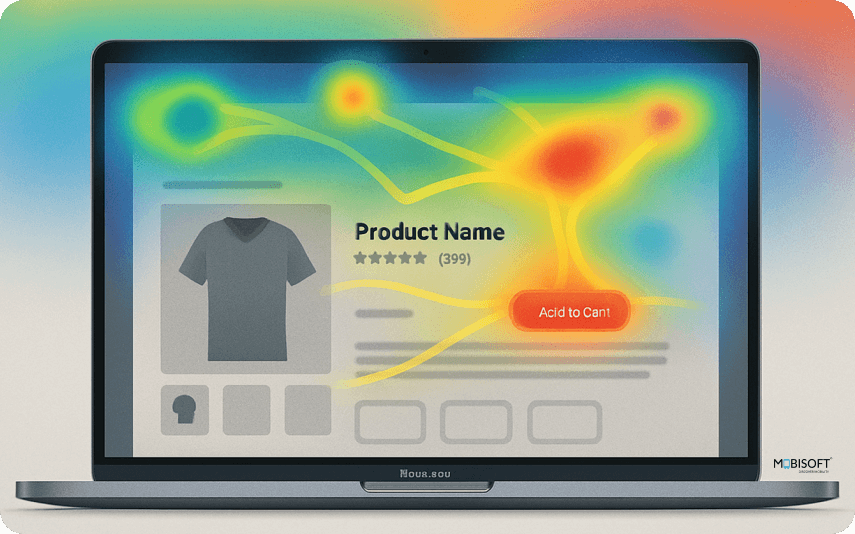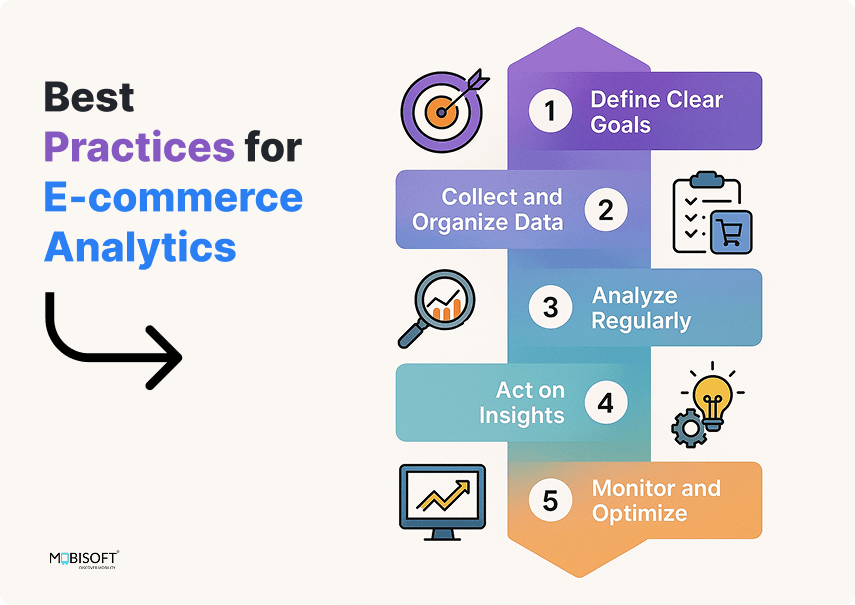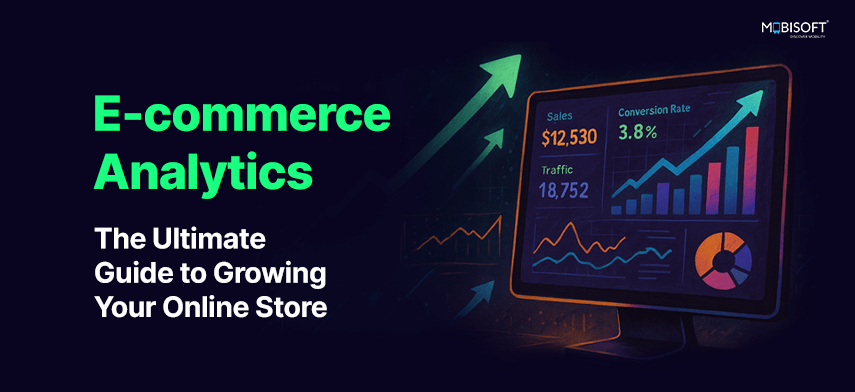Data drives every choice in the online marketplace. E-commerce analytics is the foundation that enables sustainable growth, improved strategies, and enduring competitiveness for e-commerce businesses. This guide provides the ammunition to harness the power of e-commerce data analytics for success, drive growth, improve operational efficiency, and build engaging customer experiences that endure.
Introduction: Why Analytics Matters in E-commerce
Operating an online store without e-commerce analytics tools is a shot in the dark. There is some creativity and intuition, but consistent growth relies on facts. E-commerce data insights show you what your customers are looking for, how they act, and where your efforts are translating into results. With that level of transparency, you can focus on what works, building smarter strategies, improving the customer experience, and driving sales with intent.
Source: Ecommerce Analytics: How to Leverage the Power of Data for Your Business
What is E-commerce Analytics?
E-commerce analytics gives you full visibility into everything happening across your online business. It’s about tracking customer behavior analytics, campaign performance, product flow, and identifying e-commerce performance metrics that truly matter. Rather than guessing what’s working, you have facts. These insights help boost your growth rate, enhance operational efficiency, and deliver better customer experiences.
Learn more about our custom e-commerce development services.

Key Benefits of Leveraging Analytics
Informed Decision-Making
Make strategic choices based on facts, not guesswork.
Optimized Marketing
Allocate budget to high-performing channels and campaigns.
Improved Customer Experience
Identify and address pain points in the user journey.
Increased Revenue
Use data to boost conversion rates, average order value, and repeat purchases.
Competitive Advantage
Spot trends and adapt faster than competitors.
If you're planning to scale your store, don't miss these essential e-commerce features that every high-converting platform needs.
Essential E-commerce Analytics Tools
Selecting the right analytics tools for e-commerce is critical for accurate reporting and insights. Here are the top options for 2025:
| Tool | Best For | Key Features |
| Google Analytics | All businesses | Free, real-time tracking, marketing & sales performance |
| Kissmetrics | Customer behavior & retention | Multi-channel tracking, segmentation, A/B testing |
| Optimizely | Website optimization & A/B testing | Experimentation, conversion rate optimization |
| Crazy Egg | Visual behavior analysis | Heatmaps, user session recordings |
| Adobe Analytics | Enterprise-level insights | Predictive analytics, deep segmentation, and real-time data |
| Sitecore | Customer journey & engagement | Path analysis, value scoring, and personalization |
Source: 5 Best Ecommerce Analytics Tools for 2025
Core Analytics Strategies for Growth

1.Audience Segmentation
Segment your customers based on demographics, behavior, purchase history, and preferences. This enables the customers to be personalized and targeted, thereby improving conversion and customer satisfaction through e-commerce analytics for growth.
2. Customer Behavior Analysis
Track how users navigate your site, what they view, where they drop off, and what drives them to purchase. Use these e-commerce data analytics insights to optimize site layout, product pages, and checkout flows for higher engagement and sales.
3. A/B Testing
Experiment with different versions of landing pages, product descriptions, or checkout processes. Use analytics to determine which variants perform best, then implement the winners to maximize conversions and average order value using e-commerce conversion analytics.
4. Recommendation Engines
Use e-commerce data analytics and machine learning to generate personalized product suggestions, enhancing upsell and cross-sell potential like Amazon and Netflix.
5. Market Basket Analysis
Compare what products are generally purchased together to guide bundling efforts and direct promotions.
Source: How to Use eCommerce Data Analytics to Increase Revenue
Optimizing Marketing Campaigns with Analytics

Measure Campaign Effectiveness
Track the ROI of Google Ads, email marketing, and social media campaigns. Shift budget to the highest performers and refine underperforming tactics.
Forecast Trends
Use historical data to predict demand, plan inventory, and align marketing with seasonal spikes.
Attribution Modeling
Understand which channels and touchpoints contribute most to conversions, enabling smarter allocation of resources.
Personalization and Segmentation
Personalized Offers
Use analytics to deliver dynamic content, tailored discounts, and product recommendations based on user behavior and preferences.
Dynamic Content
Serve unique homepages, emails, and ads to different customer segments for higher engagement and loyalty.
Pricing and Inventory Optimization
Dynamic Pricing
Analyze customer segments, competitor pricing, and demand to set optimal prices for maximum revenue using ecommerce dashboard analytics.
Inventory Analytics
Monitor stock levels, predict demand, and avoid overstocking or stockouts to improve profitability and customer satisfaction.
Merchandising Analysis
Identify trending products and prioritize them in your store layout and promotions, supported by e-commerce KPI tracking, a key component in delivering competitive retail e-commerce solutions.
Enhancing User Experience Through Data

Checkout Optimization
Identify and remove friction points in the checkout process to reduce cart abandonment.
Site Performance
Use heatmaps and user session recordings to spot usability issues and improve site navigation, applying analytics and e-commerce techniques.
Customer Feedback Analysis
Analyze reviews and social sentiment to address pain points and enhance satisfaction.
Discover our capabilities in e-commerce mobile app development.
Best Practices for E-commerce Analytics

Define Clear Goals:
Know what you want to achieve higher sales, better retention, improved UX, and align your analytics efforts accordingly.
Collect and Organize Data
Set up robust tracking across all touchpoints and integrate data from marketing, CRM, and sales systems.
Analyze Regularly
Don’t just collect data, review and interpret it frequently to spot trends and opportunities.
Act on Insights
Use data to drive continuous improvement in marketing, product, and customer experience.
Monitor and Optimize
Track the impact of changes and keep refining your strategies for ongoing growth.
Common Challenges and How to Overcome Them
Data Overload
Avoid distraction by focusing on high-impact e-commerce performance metrics that reflect business priorities.
Tracking Issues
Ensure proper implementation of analytics tools for accurate data collection.
Integration Complexity
Use platforms that consolidate data from multiple sources for a unified view.
Privacy Concerns
Stay compliant with regulations and use e-commerce analytics in a transparent, customer-centric manner.
Source: eCommerce Analytics Data Challenges
FAQs: E-commerce Analytics
Q: What are the most important e-commerce metrics to track?
A: Conversion rate, average order value, customer lifetime value, cart abandonment rate, traffic sources, and ROI on marketing campaigns are key metrics.
Q: How often should I review my analytics?
A: Regularly, ideally weekly or monthly, to catch trends early and respond quickly.
Q: Can small businesses benefit from analytics?
A: Absolutely. Even basic analytics can uncover actionable insights that drive growth for businesses of any size.
Q: What’s the best way to start with analytics?
A: Begin with free tools like Google Analytics, define your goals, and focus on core metrics. Expand to advanced tools as your needs grow.
Conclusion & Next Steps
E-commerce analytics is your roadmap to growth. By collecting, analyzing, and acting on e-commerce data insights, you can optimize every aspect of your business, leveraging e-commerce analytics tools to improve marketing, pricing, inventory management, and customer experience.
The brands that adopt a strategic approach to e-commerce analytics for growth and integrate custom e-commerce solutions into their technology stack will outpace their competition, delight their customers, and drive sustained revenue growth.
Ready to unlock the full potential of your e-commerce data? Contact Mobisoft Technologies for expert analytics solutions that drive measurable growth.
Explore our AI-powered analytics platforms and see how data-driven insights, backed by e-commerce success case study results, can transform your online business today!
Citations:
1.100+ Best SEO Keywords for Ecommerce Businesses
2. How to Use eCommerce Data Analytics to Increase Revenue
3. eCommerce Analytics 101 | What is eCommerce Analytics | Saras Analytics
4. 5 Best Ecommerce Analytics Tools for 2025
5. Ecommerce Analytics: Using Data to Drive Enterprise Sales
6. Top 10 eCommerce Analytics Tools To Boost Sales In 2025 - SmartOSC
7. Ecommerce Analytics: Unveiling Tools and Strategies for Maximizing Growth in 2024
8. Ecommerce Keyword Research: Proven Strategies + Tools
9. Popular Ecommerce Keywords | WordStream
10. Ecommerce Keyword Research tool | Semrush App Center
11. How to Leverage Predictive Analytics for Ecommerce
12. How to Leverage Ecommerce Performance Analytics for 30% Revenue Growth
13. Why Data Analytics is Vital for eCommerce Success | Salesfire
14. How E-commerce and D2C Brands Can Use Analytics to Accelerate Growth? - DAIOM
15. Leveraging Data Analytics for E-commerce Growth
16. Ecommerce Analytics: How to Use Data for Growth [2025]
17. Leveraging Data Analytics for E-Commerce Growth
18. What is Ecommerce Keyword Analytics and how does it work?
19. Free Ecommerce Keyword Tool - Backlinko
20. 500+ Top Ecommerce Keywords in 2025
21. Ecommerce Keyword Research Guide: Tips and Strategies for 2025 - Shopify India
22. Advanced Keyword Research Techniques for E-commerce Success
23. Ranking for E-commerce in 2025: Navigating the Changing SERPs and Beyond
24. E-commerce Manager interview questions | micro1
25. Metrics, Tools, & Best Practices of Ecommerce Analytics
26. 7 Competitive Analysis Tactics Boosting Ecommerce Retail Sales
27 .5-Step Content Gap Analysis: How to Identify and Fill the Gaps





 June 19, 2025
June 19, 2025


